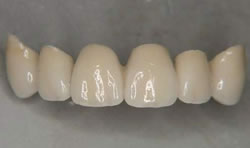Veneers:
Veneers are thin pieces of porcelain or a composite resin cemented over the front of your teeth to change their color or shape. Veneers are used on teeth with uneven surfaces or that are chipped, discolored, oddly shaped, unevenly spaced or crooked.
Veneers have a longer life expectancy and greater color stability than bonding, and highly resist permanent staining from coffee, tea, or even cigarette smoking. Usually, about a half a millimeter of the tooth is removed, which may require a local anesthetic.
A mold is taken of the tooth, and sent to the laboratory for the fabrication of the veneers. Once veneers return from the laboratory a special cement is applied between the veneer and tooth and then hardened.
Bleaching / Whitening:
Teeth become stained or discolored for a variety of reasons. Whitening procedures have effectively restored the smile of people with stained, dull, or discolored teeth. More and more people today are choosing tooth-whitening procedures to reverse the effects of aging and abuse from food and tobacco stains.

There are two main categories for the causes of staining, intrinsic and extrinsic staining.
Extrinsic staining is caused by factors such as food, coffee or tea. Food particles from products like coffee and tea, berries and soy sauce are notorious for staining teeth. Over time, teeth actually become more absorbent and vulnerable to staining from food and other substances. Conscientious brushing, flossing and rinsing can help prevent extrinsic staining. Some commercially available "whitening toothpastes" can be somewhat effective at removing stains and making teeth a few shades brighter. However, many of these products have abrasive substances that can actually wear away your tooth's enamel.
Professional whitening performed by our office is considered to be the most effective and safest method. However, over-the-counter whitening systems are somewhat effective as long as they are monitored and directions followed closely.
Intrinsic staining is caused by a variety of factors as well. These include the darker dentin layer of teeth becoming exposed as the outer layer of enamel is worn away by the effects of aging or things like caffeine and tobacco, traumatic injuries, some medications and ingestion of excessive fluoride resulting in fluorosis. These stains actually begin inside the tooth and brushing and flossing don't help.
For example, bleaching agents have a difficult time removing brownish or grayish stains. These products also are not as effective on pitted or badly discolored teeth, or on restorations such as crowns, bridges, bonding and tooth-colored fillings (porcelain veneers or dental bonding may be more appropriate in this case).
Porcelain / Zirconia Crowns:
Crowns are typically used to restore a tooth's function and appearance following a restorative procedure such as a root canal. When decay in a tooth has become so advanced that large portions of the tooth must be removed, crowns are often used to restore the tooth.
Crowns are also used to attach bridges, cover implants, prevent a cracked tooth from becoming worse, or an existing filling is in jeopardy of becoming loose or dislocated. Crowns also serve an aesthetic use, and are applied when a discolored or stained tooth needs to be restored to its natural appearance.
A tooth must usually be reduced in size to accommodate a crown. An impression is made of the existing tooth and the impression is then sent to a special lab, which manufactures a custom-designed crown. A temporary crown is applied until the permanent crown is ready.
Permanent crowns are cemented in place. With proper oral hygiene and care, a good quality crown can last up to ten years or longer.
Crowns are fabricated using gold, porcelain fused to gold, zirconia or lithium disilicate.
Porcelain / Zirconia Bridges:
 Dental bridges literally bridge
the gap created by one or more missing teeth. Bridges can restore your smile, restore your ability to properly chew
and speak and maintain the normal shape of your face.
Dental bridges literally bridge
the gap created by one or more missing teeth. Bridges can restore your smile, restore your ability to properly chew
and speak and maintain the normal shape of your face.
Very important long term positive results of a bridge are that it helps distribute the forces in your bite properly by replacing missing teeth and it can prevent remaining teeth from drifting out of position.
There are three main types of dental bridges: Traditional, Cantilever and Maryland bonded bridges.
 Traditional bridges involve
creating a crown for the tooth or implant on either side of the missing tooth, with a pontic in between. Traditional
bridges are the most common type of bridge and are made of either porcelain fused to metal or ceramics.
Traditional bridges involve
creating a crown for the tooth or implant on either side of the missing tooth, with a pontic in between. Traditional
bridges are the most common type of bridge and are made of either porcelain fused to metal or ceramics.
Cantilever bridges are used when there are adjacent teeth on only one side of the missing tooth or teeth.
Maryland bonded bridges, also called resin-bonded bridges are made of plastic teeth and gums supported by a metal framework. Metal wings on each side of the bridge are bonded to your existing teeth.
A bridge is made up of two crowns for the teeth on either side of the gap – these two anchoring teeth are called abutment teeth – and a false tooth/teeth in between. These false teeth are called pontics and can be made from gold, alloys, porcelain, or a combination of these materials. Dental bridges are supported by natural teeth or implants.
Bonding:
Bonding is a procedure in which a tooth colored resin material is applied and hardened with a special light, which ultimately "bonds" the material to the tooth to restore or improve your smile. The material is usually a durable plastic matching the color of the adjacent teeth.
Dental bonding is an potion that can be considered to repair decayed teeth, repair chipped or cracked teeth, improve the appearance of discolored teeth, or to close spaces between teeth, make your teeth look longer or to change their shape. It can also be used as a cosmetic alternative to amalgam fillings or to protect a particular portion of the tooth root that has been exposed when gums recede.
Implants:
Before development of dental implants, dentures were the only alternative to replacing a missing tooth or teeth. Implants are synthetic structures that are placed in the area of the tooth normally occupied by the root. Implants are anchored to the jawbone and act as a foundation for an artificial tooth or permanent bridge. In some cases, implants can be used to attach dentures.
Implants mimic the look and feel of natural teeth and are made of biocompatible materials. A surgical procedure is necessary to place implants in the mouth. Following the procedure, a period of time is required for the bone around the implant to adhere tightly to the implant. Once this osseointegration is complete the abutment and crown are prepared and placed on the implant.
Our implants are surgically placed by a qualified oral surgeon or periodontist.


